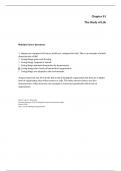Chapter 01 The Study of Life Multiple Choice Questions 1. Organs are composed of tissues, which are composed of cells. This is an example of which characteristic of life? A. Living things grow and develop. B. Living things respond to stimuli. C. Living things maintain themselves by homeostasis. D. Living things have levels of hierarchical organization. E. Living things are adapted to the environment. Organs represent one level in the hierarchy of biol ogical organization but they are a higher level of organization than either tissues or cells. The other answer choices are also characteristics of life; however, the example is concerned specifically with levels of organization. Bloom's Level: 1. Reme mber Learning Outcome: 01.01.01 Identify the basic characteristics of life. Section: 01.01 Topic: Levels of Biological Organization 2. The smallest unit that has all of the characteristics of life is the A. cell. B. tissue. C. organ. D. organ s ystem. E. organism. The cell is the basic unit of life. Some organisms are single -celled; however, others are comprised of cells arranged into tissues, organs, and organ systems. Bloom's Level: 1. Remember Learning Outcome: 01.01.02 Distinguish b etween the levels of biological organization. Section: 01.01 Topic: Levels of Biological Organization 3. Which level of biological organization is composed of several tissues? A. organism B. organ system C. organ D. cell E. molecules Organs are composed of tissues working together in a common set of functions. Tissues are collections of cells, and cells are made up of various molecules. Organs make up organ systems, which comprise the organism. Bloom's Level: 1. Reme mber Learning Outcome: 01.01.02 Distinguish between the levels of biological organization. Section: 01.01 Topic: Levels of Biological Organization 4. Which sequence correctly lists the different levels of biological organization, from the smallest and s implest to the largest and most complex? A. cells -organs -tissues -organ systems -organism B. cells -tissues -organ systems -organs -organism C. tissues -cells -organs -organ systems -organism D. tissues -organs -organ systems -organism -cells E. cells -tissues -organs -organ systems -organism The cell is the smallest, simplest unit of life. Cells are organized into tissues, which make up organs. A group of organs working together for a common set of functions comprises an organ system. An individual organism con tains several organ systems. Bloom's Level: 1. Remember Learning Outcome: 01.01.02 Distinguish between the levels of biological organization. Section: 01.01 Topic: Levels of Biological Organization 5. Which statement concerning reproduction is false? A. Hereditary information is passed on to the next generation. B. Hereditary information is in the form of genes. C. The offspring of asexual organisms have the same genes as the single parent. D. The offspring of sexual org anisms have roughly one half of the genes from each parent. E. The offspring of multicellular organisms tend to be identical to the parent. Multicellular organisms generally use sexual reproduction, in which each parent contributes to the genetic makeup of the offspring; thus, the offspring is not genetically identical to either parent. Bloom's Level: 1. Remember Learning Outcome: 01.01.01 Identify the basic characteristics of life. Section: 01.01 Topic: Characteristics of Life 6. Which sequence of classification categories is in the proper order from least to most inclusive? A. genus, class, kingdom, domain, order, phylum, species, f amily B. domain, class, genus, family, species, order, phylum, kingdom C. species, genus, family, order, class, phylum, kingdom, domain D. genus, species, order, class, family, kingdom, domain, phylum E. species, genus, family, class, order, phylum , kingdom, domain The correct sequence is species, genus, family, order, class, phylum, kingdom, domain. Species is the least inclusive category in the taxonomic hierarchy; domain is the most inclusive. Bloom's Level: 1. Remember Learning Outcome: 0 1.02.01 Describe how living things are classified. Section: 01.02 Topic: Levels of Biological Organization




